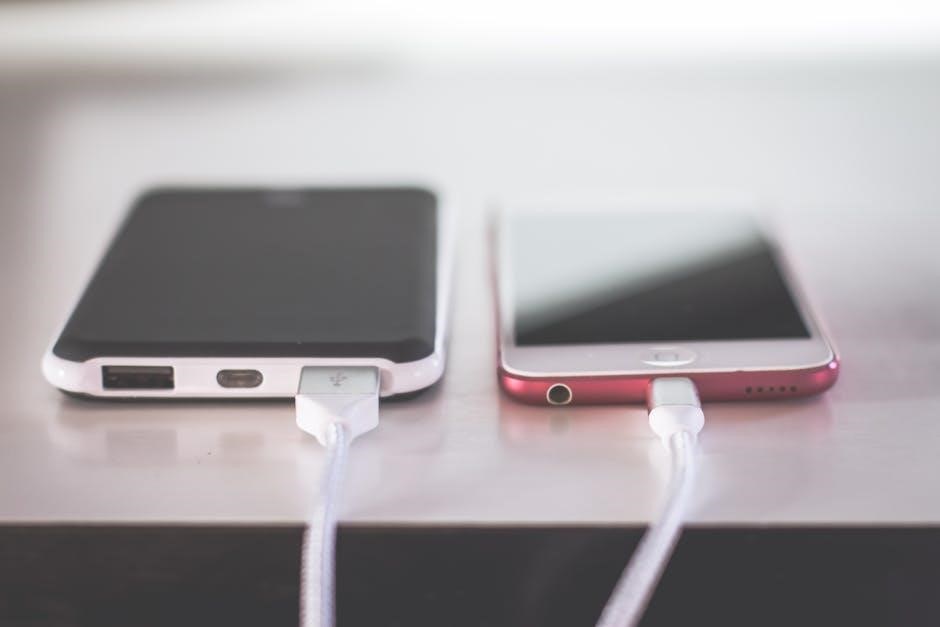This manual provides essential guidelines for using the DieHard Battery Charger, ensuring safe and efficient charging; It covers setup, operation, and troubleshooting for optimal performance.
1.1 Overview of the DieHard Battery Charger
The DieHard Battery Charger is a versatile, microprocessor-controlled device designed for efficient battery charging. It features automatic operation, an engine starter function, and built-in safety protections. Suitable for various battery types, it ensures precise charging and longevity, making it ideal for both home and light commercial use.
1.2 Importance of Reading the Manual
Reading the manual ensures safe and proper use of the DieHard Battery Charger. It provides critical safety precautions, operating instructions, and troubleshooting tips. Understanding the guidelines helps prevent accidents, extends equipment life, and ensures optimal performance. Always follow the instructions to maximize efficiency and avoid potential hazards.
Safety Precautions and Warnings
Always follow safety guidelines to prevent accidents. Wear protective gear, avoid overcharging, and keep the area well-ventilated. Ensure proper handling of batteries and chargers to maintain safety.
2.1 General Safety Guidelines
Read and follow all safety rules before using the DieHard Battery Charger. Wear protective eyewear and gloves, and ensure the area is well-ventilated. Avoid overcharging and keep the charger away from flammable materials. Properly connect the charger to the battery, following the instructions carefully to prevent damage or injury. Always unplug the charger when not in use to maintain safety.
2.2 Handling the Battery and Charger
Inspect the battery and charger for damage before use. Avoid reverse connections to prevent damage. Store the battery in a cool, dry place. Keep the charger away from direct sunlight and moisture. Disconnect the battery before charging and use insulated tools to prevent sparks. Always follow proper handling techniques to ensure safety and longevity.
2.3 Emergency Procedures
In case of an emergency, disconnect the charger immediately. Ventilate the area if gases are released. Wear protective gear to handle spills or leaks. Neutralize battery acid with baking soda and flush with water. Seek professional help for severe incidents. Always follow proper emergency protocols to ensure safety and minimize potential damage.

Installation and Setup
Begin by unpacking and inventorying all components. Mount the charger securely and connect power. Follow initial setup instructions for microprocessor-controlled models. Refer to sections 3.1-3.3 for detailed guidance.
3.1 Unpacking and Inventory
Carefully unpack the DieHard Battery Charger, ensuring all components are included. Verify the charger, power cord, cables, and manual are present. Check for any visible damage. Inventory helps ensure a smooth setup process and proper functionality of the device.
3.2 Mounting the Charger
Mount the DieHard Battery Charger securely to a stable surface. Use the provided brackets to ensure proper installation. Follow the manual’s instructions to avoid damage and ensure safe operation. Secure mounting prevents movement during charging and protects the device from potential wear and tear.
3.3 Initial Configuration
After mounting, configure the charger by navigating the menu to select battery type and charging mode. Set voltage and current limits according to the battery specifications. Ensure all connections are secure and follow the manual’s guidelines for proper initialization. This step ensures the charger operates safely and efficiently for your specific battery needs.
Charging Procedures
Connect the charger to the battery, select the correct charging mode, and monitor the process. Always follow safety guidelines and manufacturer instructions for optimal charging results.
4.1 Connecting the Charger to the Battery
Connect the charger to the battery, ensuring correct polarity: positive to positive, negative to negative. Avoid short circuits and ensure all cables are secure. Always follow the manufacturer’s instructions for proper connection to prevent damage or safety hazards.
4.2 Selecting the Correct Charging Mode
Select the appropriate charging mode based on your battery type and needs. Use the microprocessor-controlled settings for precise charging. Choose between automatic, manual, or specific battery-type modes. Ensure the mode matches your battery’s requirements for safe and efficient charging. Always refer to the manual for mode descriptions and recommendations.
4.3 Monitoring the Charging Process
Monitor the charging process using the charger’s display or indicator lights. The microprocessor-controlled system provides real-time updates on charge levels and potential issues. Ensure the battery reaches the desired voltage before disconnecting. Regularly check connections for stability and signs of wear. Refer to the manual for troubleshooting guidance if any irregularities occur during charging;

Troubleshooting Common Issues
This section helps identify and resolve common issues with the DieHard Battery Charger, such as error codes, charging problems, and connection issues, ensuring optimal performance for efficient battery maintenance.
5.1 Identifying Error Codes
The DieHard Battery Charger displays specific error codes to indicate issues. Refer to the manual for code meanings, such as battery faults or charging malfunctions, and follow corrective steps to resolve them effectively for uninterrupted operation.
5.2 Resolving Charging Problems
To address charging issues, first check all connections for tightness and damage. Ensure the charger is set to the correct battery type and voltage. If problems persist, restart the charger or consult the error code list in the manual for specific solutions. Contact customer support if issues remain unresolved.
5.3 Diagnostic Tests
Perform diagnostic tests to identify issues with the charger or battery. Use the charger’s display to check error codes and battery health. Test the charging system by monitoring voltage and current output. Refer to the manual for specific test procedures and interpretation of results for accurate troubleshooting and maintenance.

Maintenance and Care
Regularly clean the charger and inspect cables for damage. Store the unit in a dry, cool place to ensure longevity. Follow maintenance tips for optimal performance.
6.1 Cleaning the Charger
Use a soft, dry cloth to wipe the charger’s exterior. Avoid harsh chemicals or abrasive materials. For tough stains, lightly dampen the cloth with water, but ensure the charger is unplugged. Regular cleaning prevents dust buildup and ensures proper heat dissipation and functionality. Always allow the charger to dry completely before use.
6.2 Inspecting Cables and Connections
Regularly inspect the charger’s cables and connections for signs of wear, fraying, or corrosion. Ensure all plugs and terminals are secure and free from debris. Avoid overloading the charger with additional devices. Keep cables organized to prevent tangles or damage. This helps maintain safe and reliable charging performance over time.
6.3 Storing the Charger
Store the DieHard Battery Charger in a cool, dry place, away from direct sunlight and moisture. Avoid extreme temperatures and ensure the charger is unplugged. Keep it in its original packaging or a protective case to prevent damage. Regular storage maintenance ensures longevity and reliable performance when needed.
Advanced Features of the DieHard Charger
The DieHard Charger features microprocessor-controlled charging for precise battery management, an automatic engine starter for emergencies, and built-in battery and alternator testing for comprehensive diagnostics.
7.1 Microprocessor-Controlled Charging
The DieHard Charger uses advanced microprocessor technology to optimize charging. It automatically adjusts voltage and current for safe, efficient charging, preventing overcharging and extending battery life. This feature ensures compatibility with various battery types, providing precise control and reliability during the charging process for consistent performance.
7.2 Automatic Engine Starter Function
The DieHard Charger features an automatic engine starter function, enabling quick jump-starts without external power. It detects battery voltage and automatically adjusts energy output, ensuring safe and efficient engine starting; This function is designed for emergency situations, providing reliable performance while protecting against overcharge and short-circuit scenarios, making it a versatile and user-friendly solution.
7.3 Battery and Alternator Testing
The DieHard charger includes a battery and alternator testing feature, enabling users to assess their condition. It checks charge levels, voltage, and detects faults. Clear results indicate health status, ensuring your system operates efficiently. Regular testing helps prevent unexpected failures, promoting key reliability and longevity of your vehicle’s electrical system.

Warranty and Support Information
This DieHard Battery Charger is backed by a three-year full warranty. Coverage includes defects in materials and workmanship when used as directed. Contact customer support for assistance.
8.1 Warranty Coverage Details
The DieHard Battery Charger is covered by a three-year full warranty, ensuring protection against defects in materials and workmanship. This warranty applies when the product is used according to the provided instructions and guidelines. For any issues, contact DieHard customer support to initiate the warranty claim process effectively and efficiently.
8.2 Contacting Customer Support
For assistance, visit the official DieHard website or refer to the manual for contact details. Sears customer support is available to address inquiries and provide solutions. Ensure to have your model number, such as 28.71219, ready for efficient service. Online resources and support teams are dedicated to resolving issues promptly and effectively.
8.3 Registering Your Product
Register your DieHard Battery Charger by visiting the official Sears website. Provide your product’s model number, such as 28.71219 or 71222, and complete the online form. Registration ensures warranty validation and access to exclusive updates. This step is crucial for maintaining your product’s benefits and receiving timely support when needed.

Environmental and Disposal Considerations
Dispose of batteries and chargers responsibly, following eco-friendly practices. Recycle old batteries and chargers to minimize environmental impact. Always adhere to local regulations for proper disposal procedures.
9.1 Eco-Friendly Practices
Adopt eco-friendly practices by recycling old batteries and chargers. Ensure proper disposal to prevent environmental contamination. Comply with local regulations for hazardous waste. Reduce energy consumption during charging to promote sustainability. Always follow guidelines for responsible disposal to minimize ecological impact and conserve natural resources effectively.
9.2 Proper Disposal of Batteries and Chargers
Properly dispose of batteries and chargers by recycling them at designated facilities. Remove terminal connectors to prevent accidental short circuits. Do not dispose of them in regular trash, as they contain hazardous materials. Consult local authorities for approved disposal methods to ensure environmental safety and regulatory compliance.
Always follow the manual for safe and efficient charging. Regular maintenance ensures longevity. Store the charger properly and dispose of batteries eco-friendly. Happy charging!
10.1 Summary of Key Points
Always follow safety guidelines and manual instructions for optimal performance. Ensure proper connections, select the right charging mode, and monitor the process. Regular maintenance, like cleaning and inspecting cables, extends the charger’s lifespan. Store the charger correctly and dispose of batteries eco-friendly. Refer to troubleshooting tips for common issues and warranty details for support.
10.2 Best Practices for Long-Term Use
Regularly inspect cables and connections for wear. Store the charger in a cool, dry place to prevent damage. Follow eco-friendly disposal practices for batteries and chargers. Always adhere to safety guidelines and maintenance tips outlined in the manual to ensure optimal performance and extend the lifespan of your DieHard Battery Charger.



0 Comments